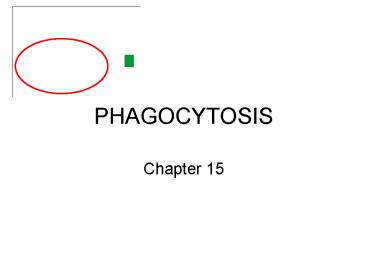PHAGOCYTOSIS - PowerPoint PPT Presentation
Title:
PHAGOCYTOSIS
Description:
PHAGOCYTOSIS Chapter 15 What is a Phagocyte? A cell that engulfs and digests material such as cell debris and microbes, including invading organisms. – PowerPoint PPT presentation
Number of Views:857
Avg rating:3.0/5.0
Title: PHAGOCYTOSIS
1
PHAGOCYTOSIS
- Chapter 15
2
- What is a Phagocyte?
- A cell that engulfs and digests material such as
cell debris and microbes, including invading
organisms. - Surface of cell contains pattern recognition
receptors to recognize material to be ingested.
3
- A scavenger receptor is an example that
recognizes materials with charged molecules on
their surface. - These receptors allow cell to bind to certain
molecular configurations on debris and foreign
material for ingestion. - Macrophages located in skin tissue destroy small
amounts of bacteria in a wound - Macrophages can produce cytokines to recruit
additional phagocytes (neutrophils) for help.
4
The Process of Phagocytosis
- A series of complex steps allowing phagocytes to
engulf and destroy invading microorganisms. - Most pathogens have evolved an ability to evade
one or more of the steps (resistance).
5
Step 1
- Chemotaxis- Phagocytic cells are recruited to
site of infection or tissue damage by chemical
stimuli (chemoattractants).
6
Step 2
- Recognition Attachment- Receptors located on
outside of phagocyte recognize and bind (directly
or indirectly). - Direct binding-receptors recognize and bind to
patterns of compounds found on invaders - Indirect binding-particle is opsonized, coating
particle with antibody substance for easier
ingestion
7
Step 3
- Engulfment-Phagocytic cell engulfs invader,
forming a membrane-bound vacuole called a
phagosome. - Cytoskeleton of phagocyte rearranges to form
armlike extensions (pseudopods) that surround
material being engulfed. -
8
Step 4
- Fusion of the phagosome with the lysosome -within
the phagocyte, the phagosome moves along the
cytoskeleton to where it can fuse with lysosomes. - Lysosomes-membrane bound bodies filled with
various digestive enzymes like lysozyme and
proteases. - Fusion creates a phagolysosome.
- In neutrophils, membrane-bound bodies are
granules.
9
Step 5
- Destruction Digestion-Oxygen consumption
increases, sugars metabolized (aerobic
respiration), highly toxic oxygen products
produced (superoxide, hydrogen peroxide, singlet
oxygen, hydroxyl radicals). - As available O2 in phagolysosome is consumed
metabolic pathway switches to fermentation,
producing lactic acid and lowering pH. - Enzymes degrade peptidoglycan of the bacterial
cell walls, and other parts of the cell.
10
Step 6
- Exocytosis-membrane-bound vesicle containing
digested material fuses with the plasma membrane.
Material is expelled to the external environment.
11
Macrophages
- Scavengers located in tissue
- Play essential role in every major tissue in the
body - Live for weeks to months
- Maintain killing power by regenerating their
lysosomes
12
- Characteristics
- Toll-like receptors-allow them to sense
dangerous materials. - Produce pro-inflammatory cytokines, alerting
other cells in the immune system. - Activated macrophages-increases killing power
with assistance from certain T cells. This
cooperation between innate and adaptive host
defenses induces production of nitric oxide and
oxygen radicals, helping to destroy microbes.
13
- If activated macrophages fail to destroy
microbes and chronic infection occurs, large
numbers can fuse together forming giant cells. - Granulomas- concentrated groups of macrophages,
T cells, giant cells. Contain organisms and
material that cant be destroyed by walling off
and retaining the debris to prevent infection of
more cells. Granulomas are commonly part of the
disease process in TB, histoplasmosis, and other
diseases.
14
Neutrophils
- Characteristics
- Known as the rapid response team. Quickly move
into an area to eliminate invaders. - Critical role in first stages of inflammation.
- First cell type recruited from bloodstream to
site of damage. - More killing power than microphages.
- Short life span (1-2 days) in the tissue.
- Expend granules, then die.
- For every neutrophil in the circulatory system,
there are 100 more waiting in the bone marrow.
15
The End

